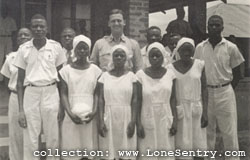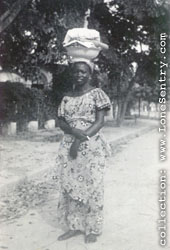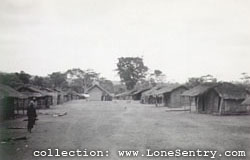|
23rd Station Hospital Photo Album
Below are selections from an extensive photo album by an officer of
the 23rd Station Hospital from 1942 - 1945.
Photos of the prisoner of war camp Stalag IXB from this album
are also on this website, see
Photo Set: Stalag IXB, Bad Orb.
| |
| |
![[Dr. Wm L. Casey, FEC Early: 23rd Station Hospital]](pics/23SH_casey_h250.jpg)
Dr. Wm L. Casey /Col, FEC Early
|
|
| |
- Units, persons, and locations mentioned in the photo album:
-
- Units: 23rd Station Hospital;
46th General Hospital; 3rd Infantry Division
- Persons:
Dr. William L. Casey;
D. Benedetto (23rd SH);
Sgt. DePhyllis;
Lt. Johnson;
Major Lowrey;
Capt. Markunas (Radiologist);
Exec. Officer [Dr. Rush E.] Netterville;
Sgt. Reimer;
Sgt. Ulrich;
Col. J. Guy Strohm (46th GH);
Sgt. Ward (46th GH);
- Locations:
Baccarat, Besancon, Bouc-Cabriès, Bourbonne, Colmar, Epinal,
Maizières, Marseilles, Metz, Mirecourt, Nancy,
Sorans, St. Die, Strasbourg, Void d'Escles, France;
Bad Orb, Heidelberg, Frankfurt, Germany;
Assi Bou Nif, Oran, Algeria;
Port Lyautey, Rabat, French Morocco;
Pointe-Noire, Leopoldville, Belgian Congo;
Nairobi, Kenya;
Luxembourg;
Camp Presnell;
If you have more information on the 23rd Station Hospital or the soldiers pictured, please contact us.
| Léopoldville, Belgian Congo |
 |
|
The 23rd Station Hospital was originally established in
Léopoldville, Belgian Congo, in September 1942 to provide
medical care for a southern ATC (Air Transport Command) route.
The hospital never reached full operation because the
proposed ATC route was abandoned by the end of the year.
|
| |
![[Camp Presnell]](pics/23SH_africa06_sm.jpg)
Camp Presnell
|
|

[unlabelled]
|
|
| |
![[Native village outside Leo Deux. 1/2/43.]](pics/23SH_africa05_sm.jpg)
Native
village outside Leo Deux. 1/2/43. Young girl carrying baby. I do
the steadying.
|
|
![[Native prisoners, Leopoldville, Belgian Congo]](pics/23SH_africa02_sm.jpg)
Native prisoners,
Leopoldville, Belgian Congo
|
|
| |
![[Native policeman]](pics/23SH_africa01_sm.jpg)
Native policeman
|
|

[unlabelled]
|
|
| |
![[Street in Nairobi]](pics/23SH_africa03_sm.jpg)
Street in
Nairobi. Notice turbans on men (who came from India).
|
|

[unlabelled]
|
|
| Port Lyautey, Morrocco |
 |
|
In April 1943, the 23rd Station Hospital was moved by plane to
Port Lyautey, Morrocco. The 23rd Station opened 250 beds under
canvas at Port Lyautey in May, expanding to 500 beds in July 1943.
|
| |
|
A rare set of color photographs taken in the region around Port Lyautey.
The film is stamped with development dates of Jan/Feb 1944. The prints
are carefully labelled, but unfortunately have become severely yellowed and faded.
|
| |
![[Ocean Front, Rabat, Fr. Morocco]](cpics/c100w250.jpg) |
|
Ocean Front - Rabat, Fr. Morocco. Too rough
rocky & precipitous for bathing. There is a small
harbor to the right between Rabat and Sale (the river
Bou Regreg separates the 2 cities. Sale was the home
of pirates & still is anti-European!
|
|
|
![[Road Pt. Lyautey to Rabat, Fr. Morocco (near Lyautey)]](cpics/c103w250.jpg) |
|
Road Pt. Lyautey to Rabat, Fr. Morocco (near Lyautey).
Lyautey to Rabat: 22 miles, Rabat to Casablanca, 65 miles.
The French line their roads with trees. Good macadam Road.
Atlantic is but few miles to right.
|
|
|
| |
![[Street scene, Rabat, French Morocco]](cpics/c102w250.jpg) |
|
Street scene - Rabat, Fr. Morocco. Camels: not as common
here as south of Casablanca to Dakar. Officers: Exec. Officer
[Rush E.] Netterville (Mississippi); Radiologist Markunas (Pennsylvania).
|
|
|
![[Cork tree: Forest of Marmora, Port Lyautey, French Morocco]](cpics/c101w250.jpg) |
|
Cork tree: Forest of Marmora (30 m. long, 10 to 12 m. wide);
Port Lyautey, Fr. Morocco. This tree had
previously been cut up to the arrow. Officer is
cutting thru new growth. [Dr. Rush E. Netterville]
|
|
|
| |
![[Cactus growth near Pt. Lyautey, French Morocco.]](cpics/c104w250.jpg) |
|
Cactus Growth - near Pt. Lyautey, Fr. Morocco.
Common scene. Used as corral for animals or enclosure about
Arab dwelling. Cactus grows higher & thicker than in states.
|
|
|
![[Entrance to Rabat, Fr. Morocco from north. Prennez l'Arche à droite.]](cpics/c201w250.jpg) |
|
Entrance to Rabat, Fr. Morocco from north. Prennez l'Arche à droite.
Rabat is a walled city with walls still in fairly good condition.
|
|
|
| |
![[Near Sultan's Palace, Rabat, French Morocco]](cpics/c202w250.jpg) |
|
Near Sultan's Palace, Rabat, Fr. Morocco
(Sultan guard & Arab woman); near
exit Rabat to Casablanca
|
|
|
![[Street scene, Rabat, French Morocco]](cpics/c203w250.jpg) |
|
Street scene, Rabat, Fr. Morocco, showing the Arab
equivalent of the auto: the donkey. Arab wearing
"Burnouses." A Moroccan "Goum" to left (native infantry soldier).
Goums fought wekk in Tunisia, Italy.
|
|
|
| |
![[Rabat, French Morocco]](cpics/c303w250.jpg) |
|
Rabat, Fr. Morocco
|
|
|
![[La Gare, Rabat, French Morocco]](cpics/c301w250.jpg) |
|
La Gare - Rabat, Fr. Morocco. Arab bus. The French "pretty"
their R.R. stations about as we do our filling stations.
|
|
|
| |
![[Public Gardens, Rabat, French Morocco]](cpics/c304w250.jpg) |
|
Public Gardens - Rabat, Fr. Morocco. Rabat is the political
& military center of Fr. Morocco. It's a planned city and the
prettiest in Morocco. French reinforcements went from here
to Lyautey to oppose U.S. landings there.
|
|
|
![[Gardens, Rabat, French Morocco]](cpics/c204w250.jpg) |
|
Gardens - Rabat, Fr. Morocco
|
|
|
| Assi Bou Nif, Algeria |
 |
|
The 23rd Station moved by train to Assi Bou Nif, Algeria (about eight miles
southeast of Oran) in September 1943. The 23rd was one of a cluster of
hospitals built around Assi Bou Nif to support Allied operations in Italy.
|
| |
![[Panoramic view of U.S. 23rd Station Hospital at Assi Bou Nif]](pics/23SH_panorama.jpg) |
|
[Panoramic view of hospital at Assi Bou Nif]
|
|
|
| |
![[23rd Sta Hosp]](pics/23SH_flagpole_overlay_sm.jpg)
|
|
![[Assi Bou Niff]](pics/23SH_assi1_sm.jpg)
Assi Bou Niff
|
|
![[Headquarters, 23rd SH, Assi Bou Niff]](pics/23SH_assi2_sm.jpg)
Hdqrs 23rd SH. Assi Bou Niff
|
|
![[Assi Bou Niff, Algeria, Sept. 1943]](pics/23SH_assi3_sm.jpg)
Assi Bou Niff, Algeria, Sept. 1943
|
|
| |
![[Hospital Area, Oran.]](cpics/c302w250.jpg)
Retreat - Hospital
Area, Oran.
|
|
![[Capt. Murkunas and Miss Lyter, Oran, September 1944]](pics/23SH_oran_sm.jpg)
Capt. Murkunas, Miss Lyter.
Oran. Sept 6/44.
|
|
| Epinal, France |
 |
|
In September 1944, the hospital moved by Navy transport to Marseille, France, and
then by hospital train to Epinal, France.
|
| |
![[Sgts. Ulrich and Reimer, Epinal, France, October 1944]](pics/23SH_epinalsign_sm.jpg) |
Sgts. Ulrich - Reimer.
Epinal, France. Oct. 44.
|
|
|
![[Sgt. DePhyllis, Epinal, France, Sept. 1944]](pics/23SH_dephyllis_sm.jpg) |
Sgt. DePhyllis.
Epinal, France. Sept. 1944.
|
|
|
| |
![[Col. J. Guy Strohm (Portland, Oregon), 46th Gen. Hosp. U.S., Besancon, France, 1945.]](pics/23SH_colstrohm_sm.jpg) |
Col. J. Guy Strohm (Portland, Oregon).
46th Gen. Hosp. (U.S.).
Besancon, France. Mar. 1945.
|
|
|
![[Dummy soldier, Outside Colmar, France, Feb. 1945]](pics/23SH_dummy_sm.jpg) |
Outside Colmar, France.
Feb 10/45.
[dummy soldier]
|
|
|
| |
![[Car of 23rd Station Hospital]](pics/23SH_car_sm.jpg) |
[bumper markings "CAS-23M" & "STA-1"
CAS = Continental Advance Section]
|
|
|
![[D. Benedetto, 23rd S.H., and Sgt. Ward (Univ. Missouri), 46th G.H, Besancon, France, March 1945]](pics/23SH_fort_sm.jpg) |
D. Benedetto (Chauffeur), 23rd S.H.
Sgt. Ward (Univ. Missouri), 46th G.H.
Roman Gate - Besancon, France. Mar. 45.
|
|
|
| |
![[Colmar, France]](pics/23SH_citygroup_sm.jpg) |
|
[Colmar, France]
|
|
|
![[Colmar, France, Feb. 1945]](pics/23SH_colmar1_sm.jpg) |
|
Colmar, France. Feb 10/45
|
|
|
| |
![[Cathedral, Epinal, France, October 1944]](pics/23SH_scfrance01_sm.jpg) |
Cathedral. Epinal, France.
Oct. 1944
|
|
|
![[Baccarat, France, Nov. 1944.]](pics/23SH_scfrance02_sm.jpg) |
|
Baccarat, France, Nov 10/44.
|
|
|
| |
![[Maizieres, north of Metz, March 1945]](pics/23SH_scfrance03_sm.jpg) |
|
Maizieres - N. of Metz, Mar. 15/45
|
|
|
![[Hauptschule, Maizieres, north of Metz, March 1945]](pics/23SH_scfrance04_sm.jpg) |
|
Maizieres - north of Metz, Mar. 15/45
|
|
|
| |
![[Mirecourt, March 1945]](pics/23SH_scfrance05_sm.jpg) |
|
Mirecourt, Mar. 16/45
|
|
|
![[Cathedral St. Die, France]](pics/23SH_stdie1_sm.jpg) |
Cathedral St. Die, France.
Destroyed by Germans (mines)
|
|
|
| |
![[Marseilles, France, September 1944]](pics/23SH_mars_sm.jpg) |
|
Marseilles, France. Sept. '44
|
|
|
![[Bivouac Area, Bouc. Cabries, France, Sept. 1944]](pics/23SH_scfrance06_sm.jpg) |
|
Bivouac Area, Bouc. Cabries, France. Sept. 1944.
|
|
|
| |
![[Group photo, January 1945]](pics/23SH_jan45_sm.jpg) |
|
Jan. 1945
|
|
|
![[Pont a Moussons, Rube Goldberg]](pics/23SH_pont_sm.jpg) |
Pont a Moussons "Rube Goldberg"
Mar. 15/45.
|
|
|
| Into Germany |
 |
|
From the photographs, at least some men from the unit
entered Germany, crossed the Rhine, visited
Stalag IXB at Bad Orb, and moved to Heidelberg.
|
| |
| |
|
|
|
|
Three unlabelled photographs.
[Checking the history of the 36th Infantry Division,
the photos show the customs house gateway at Schweigen, Germany. The sign identifies
the 142nd Regiment as the first unit through the arch.]
|
|
|
| |
| |
|
Several unlabelled photos of the Siegfried Line:
the bunker "Trotzkopf" and rows of dragons' teeth anti-tank obstacles.
|
| |
|
|
|
|
| |
| |
|
More miscellaneous photos from
Germany. From the signposts, the photographer went at least as
far as Heidelberg.
|
| |
![[Heidelberg, Germany]](pics/23SH_heidelberg1_sm.jpg) |
|
[unlabelled]
|
![[On our way back, just ready to cross the Rhine]](pics/23SH_rhine1_sm.jpg) |
|
On our way back, just ready to cross the Rhine.
|
![[Frankfurt, Germany]](pics/23SH_germany2_sm.jpg) |
|
Frankfurt - Where I almost forgot it would cost me $64.00
|
|
|
![[Heidelberg, Germany]](pics/23SH_heidelberg2_sm.jpg) |
|
[Heidelberg]
|
![[Someplace in Germany]](pics/23SH_germany1_sm.jpg) |
Do not recall where this was
taken. Someplace in Germany.
|
|
|
| |
![[Destroyed Bridge]](pics/23SH_bridge1_sm.jpg) |
|
[unlabelled]
|
|
|
![[Destroyed Bridge]](pics/23SH_bridge2_sm.jpg) |
|
[unlabelled]
|
|
|
| Miscellaneous |
 |
| |
| |
![[Group photo]](pics/23SH_group_sm.jpg) |
|
[unlabelled]
|
|
|
![[23rd Station Hospital, probably Epinal, France]](pics/23SH_winterhospital_sm.jpg) |
|
[unlabelled photo of 23rd Hospital, probably Epinal, France]
|
|
|
| |
![[Liberated French on their way back]](pics/23SH_french1_sm.jpg) |
|
Liberated French on their way back
|
|
|
![[French on their way back]](pics/23SH_french2_sm.jpg) |
|
French on their way back
|
|
|
| |
![[WWII U.S. Military Convoy]](pics/23SH_convoy1_sm.jpg) |
|
[unlabelled]
|
|
|
![[WWII U.S. Military Convoy]](pics/23SH_convoy2_sm.jpg) |
|
[unlabelled]
|
|
|
| |
![[Ribeauviele(?) at Field Hospital. 2 Major Lowreys]](pics/23SH_officers1_sm.jpg) |
Ribeauviele(?) at Field Hospital.
2 Major Lowreys
|
|
|
![[Just before leaving Frosty. A double exposure which shows wholesale destruction of Germany in background.]](pics/23SH_officers2_sm.jpg) |
|
Just before leaving Frosty. A double exposure which
shows wholesale destruction of Germany in background.
|
|
|
Notes:
Alternate Designations: 23d S.H.; 23rd S.H.; 23d Sta. Hosp.; 23rd Sta. Hosp.;
23d Station Hospital; Twenty-Third Station Hospital.
|
|
![[Lone Sentry: U.S. 23rd Station Hospital WWII Photo Album]](../pics/sentrysmall.jpg)
![[Lone Sentry: Photos, Articles, and Research on the European Theater in World War II]](../pics/lonesentrylogo.jpg)
![[Dr. Wm L. Casey, FEC Early: 23rd Station Hospital]](pics/23SH_casey_h250.jpg)

![[Camp Presnell]](pics/23SH_africa06_sm.jpg)

![[Native village outside Leo Deux. 1/2/43.]](pics/23SH_africa05_sm.jpg)
![[Native prisoners, Leopoldville, Belgian Congo]](pics/23SH_africa02_sm.jpg)
![[Native policeman]](pics/23SH_africa01_sm.jpg)

![[Street in Nairobi]](pics/23SH_africa03_sm.jpg)

![[Ocean Front, Rabat, Fr. Morocco]](cpics/c100w250.jpg)
![[Road Pt. Lyautey to Rabat, Fr. Morocco (near Lyautey)]](cpics/c103w250.jpg)
![[Street scene, Rabat, French Morocco]](cpics/c102w250.jpg)
![[Cork tree: Forest of Marmora, Port Lyautey, French Morocco]](cpics/c101w250.jpg)
![[Cactus growth near Pt. Lyautey, French Morocco.]](cpics/c104w250.jpg)
![[Entrance to Rabat, Fr. Morocco from north. Prennez l'Arche à droite.]](cpics/c201w250.jpg)
![[Near Sultan's Palace, Rabat, French Morocco]](cpics/c202w250.jpg)
![[Street scene, Rabat, French Morocco]](cpics/c203w250.jpg)
![[Rabat, French Morocco]](cpics/c303w250.jpg)
![[La Gare, Rabat, French Morocco]](cpics/c301w250.jpg)
![[Public Gardens, Rabat, French Morocco]](cpics/c304w250.jpg)
![[Gardens, Rabat, French Morocco]](cpics/c204w250.jpg)
![[Panoramic view of U.S. 23rd Station Hospital at Assi Bou Nif]](pics/23SH_panorama.jpg)
![[23rd Sta Hosp]](pics/23SH_flagpole_overlay_sm.jpg)
![[Assi Bou Niff]](pics/23SH_assi1_sm.jpg)
![[Headquarters, 23rd SH, Assi Bou Niff]](pics/23SH_assi2_sm.jpg)
![[Assi Bou Niff, Algeria, Sept. 1943]](pics/23SH_assi3_sm.jpg)
![[Hospital Area, Oran.]](cpics/c302w250.jpg)
![[Capt. Murkunas and Miss Lyter, Oran, September 1944]](pics/23SH_oran_sm.jpg)
![[Sgts. Ulrich and Reimer, Epinal, France, October 1944]](pics/23SH_epinalsign_sm.jpg)
![[Sgt. DePhyllis, Epinal, France, Sept. 1944]](pics/23SH_dephyllis_sm.jpg)
![[Col. J. Guy Strohm (Portland, Oregon), 46th Gen. Hosp. U.S., Besancon, France, 1945.]](pics/23SH_colstrohm_sm.jpg)
![[Dummy soldier, Outside Colmar, France, Feb. 1945]](pics/23SH_dummy_sm.jpg)
![[Car of 23rd Station Hospital]](pics/23SH_car_sm.jpg)
![[D. Benedetto, 23rd S.H., and Sgt. Ward (Univ. Missouri), 46th G.H, Besancon, France, March 1945]](pics/23SH_fort_sm.jpg)
![[Colmar, France]](pics/23SH_citygroup_sm.jpg)
![[Colmar, France, Feb. 1945]](pics/23SH_colmar1_sm.jpg)
![[Cathedral, Epinal, France, October 1944]](pics/23SH_scfrance01_sm.jpg)
![[Baccarat, France, Nov. 1944.]](pics/23SH_scfrance02_sm.jpg)
![[Maizieres, north of Metz, March 1945]](pics/23SH_scfrance03_sm.jpg)
![[Hauptschule, Maizieres, north of Metz, March 1945]](pics/23SH_scfrance04_sm.jpg)
![[Mirecourt, March 1945]](pics/23SH_scfrance05_sm.jpg)
![[Cathedral St. Die, France]](pics/23SH_stdie1_sm.jpg)
![[Marseilles, France, September 1944]](pics/23SH_mars_sm.jpg)
![[Bivouac Area, Bouc. Cabries, France, Sept. 1944]](pics/23SH_scfrance06_sm.jpg)
![[Group photo, January 1945]](pics/23SH_jan45_sm.jpg)
![[Pont a Moussons, Rube Goldberg]](pics/23SH_pont_sm.jpg)
![[Customs house gateway at Schweigen, Germany]](pics/23SH_customs1_sm.jpg)
![[Customs house gateway at Schweigen, Germany]](pics/23SH_customs3_sm.jpg)
![[Customs house gateway at Schweigen, Germany with sign of 142nd RCT]](pics/23SH_customs2_sm.jpg)
![[Siegfried Line Bunker]](pics/23SH_bunker2_sm.jpg)
![[Siegfried Line Bunker]](pics/23SH_bunker1_sm.jpg)
![[Siegfried Line Dragon's Teeth]](pics/23SH_dragonsteeth1_sm.jpg)
![[Siegfried Line Dragon's Teeth]](pics/23SH_dragonsteeth2_sm.jpg)
![[Heidelberg, Germany]](pics/23SH_heidelberg1_sm.jpg)
![[On our way back, just ready to cross the Rhine]](pics/23SH_rhine1_sm.jpg)
![[Frankfurt, Germany]](pics/23SH_germany2_sm.jpg)
![[Heidelberg, Germany]](pics/23SH_heidelberg2_sm.jpg)
![[Someplace in Germany]](pics/23SH_germany1_sm.jpg)
![[Destroyed Bridge]](pics/23SH_bridge1_sm.jpg)
![[Destroyed Bridge]](pics/23SH_bridge2_sm.jpg)
![[Group photo]](pics/23SH_group_sm.jpg)
![[23rd Station Hospital, probably Epinal, France]](pics/23SH_winterhospital_sm.jpg)
![[Liberated French on their way back]](pics/23SH_french1_sm.jpg)
![[French on their way back]](pics/23SH_french2_sm.jpg)
![[WWII U.S. Military Convoy]](pics/23SH_convoy1_sm.jpg)
![[WWII U.S. Military Convoy]](pics/23SH_convoy2_sm.jpg)
![[Ribeauviele(?) at Field Hospital. 2 Major Lowreys]](pics/23SH_officers1_sm.jpg)
![[Just before leaving Frosty. A double exposure which shows wholesale destruction of Germany in background.]](pics/23SH_officers2_sm.jpg)